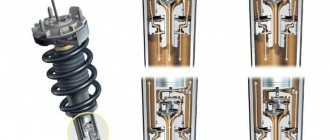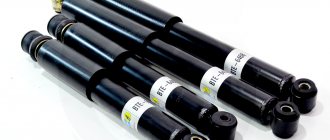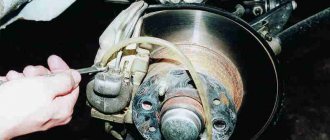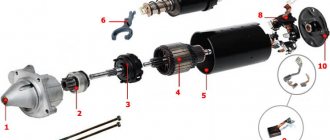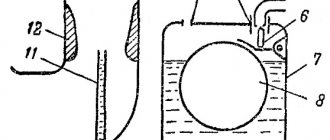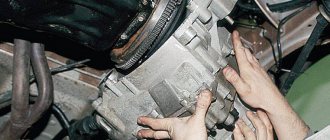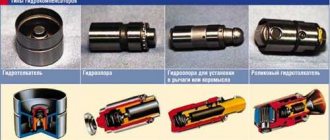A shock absorber is a damping device that is used on a car to effectively absorb shocks and shocks, dampen vibrations, etc. Also, the shock absorber (car strut) allows you to press the wheel to the road when driving on rough roads, thereby improving traction properties, increasing braking efficiency, vehicle stability, etc.
Today there are several types and types of shock absorbers, which differ not only depending on the axis on which they stand (front shock absorbers or rear shock absorbers), but also in design terms.
Next, we will look at what a shock absorber is and what a car's shock absorber is. So, within the framework of the article, a separate emphasis is placed on what types of shock absorbers there are on cars, types of struts, how they differ, and also the advantages and disadvantages of various types of struts, etc. are considered.
What is a shock absorber
A modern shock absorber is a complex mechanism that dampens vibrations, absorbs shocks and ensures constant contact of the wheels with the road surface when the car is moving. It is installed next to the wheel. Using a lever system, mechanical loads (shocks and vibrations) are transmitted from the rotating wheel to the mechanism.
This part is equipped with a spring, which ensures quick return of the rod after compression when hitting a bump. If this process does not occur quickly, then the car will become uncontrollable off-road.
Sports
Designed to withstand high loads. The working fluid is temperature stable and does not lose viscosity when heated. To maintain constant adhesion of the wheels to the road, they have an increased compression force and a short rebound time, which ensures constant adhesion of the wheels to the road and good handling on turns.
The history of the shock absorber
As transport evolved, designers came to the conclusion that, in addition to a powerful and efficient power unit with a durable body, the car needed a good suspension that would soften the impact of uneven roads. The first shock absorbers had an unpleasant effect - while driving they strongly rocked the vehicle, which caused the steering to suffer greatly.
Spring shock absorbers partially damped body vibrations due to the friction force between the sheets, but this effect was not completely eliminated, especially when the vehicle was heavily loaded. This prompted designers to develop two separate elements. One was responsible for softening the impacts from the wheel on the body, and the other restored the contact patch of the wheel, springing it, quickly bringing the damper element to its original position.
At the beginning of the last century, a separate damping suspension element was developed. It was a dry friction shock absorber, which included friction discs. The first piston oil telescopic shock absorbers appeared in the 50s of the last century. The basis of their work was the principle of fluid friction.
The design of such shock absorbers was borrowed from the design of an aircraft landing gear. This type of shock absorber design is still used today.
Consequences of wear
If there is a skid, we can conclude that the shock absorber has become unusable.
Consequences Failure of the shock absorber system can lead to the following troubles:
- loss of control.
- a large passage of the path followed by crashing during heavy braking.
- decrease in directional stability.
- reduction in carrying capacity.
- failure of other suspension parts.
- feeling every bump, hole, while driving.
Shock absorber design
Most shock absorbers consist of the following components:
- Steel hollow tube (cylinder). On one side it is muffled. An eye is welded to this part, which allows you to secure the stand to the wheel hub. The reservoir is filled with liquid (a mixture of gas and liquid or gas only), which compensates for the load when the piston is compressed. A rod seal is installed on the open side, preventing fluid from leaking out of the cavity.
- Shock absorber rod. This is a steel rod, the cross-section of which depends on the model of the mechanism. It is placed in a tank. On one side, the rod is attached to a support bearing, and on the other, a piston placed inside the cylinder is attached to it.
- Piston. This element moves inside the cylinder, creating pressure on the liquid or gas inside the tube.
- Bypass valve. It is mounted on the piston and has several holes with spring-loaded valves. When the piston moves, one group of valves is activated, ensuring flow from the cavity under the piston to the part above it. Smooth running is ensured by resistance due to small holes (the liquid does not have time to move quickly between the cavities). A similar process occurs during the recoil stroke (when the piston rises), only in this case the valves of another group are activated.
The design of modern damper mechanisms is constantly being improved, which increases their efficiency and reliability. The design of shock absorbers can differ significantly depending on the modification of the mechanism. However, the operating principle remains unchanged. When pushed, the rod moves the piston inside the cylinder, which compresses the liquid or gas.
Sometimes shock absorbers are confused with gas springs, which are installed on the trunk lid or on the hood. Although they look similar, they each serve a different function. Dampers dampen shocks, and gas springs ensure smooth opening and retention of heavy lids in this position.
What is the difference between shock absorbers and struts?
The shock absorber and strut are attached differently. The rack design eliminates the need for an upper ball joint and linkage. It is attached to the lever and ball only at the bottom, and at the top it is installed in a support bearing.
The shock absorber itself is attached using silent blocks without a support bearing. The rod of the strut has a large diameter, while the rod of the shock absorber has a small diameter. Thanks to this method of fastening, the rack is able to absorb multidirectional loads, and the shock absorber - only along its axis. The shock absorber may be part of the strut.
Application
In the automotive industry
The approach to the purpose of a shock absorber in various schools of automotive engineering can to some extent be determined by the name that is given to it. For example, German Dämpfer - vibration damper (damper), English. Shock-absorber - shock absorber.
See also: Car suspension
In tank building
In tank building, the operating principle of German telescopic shock absorbers from the Second World War (Pz.III, Pz.V, Pz.VI tanks) and the friction shock absorber of the modern Leopard-2 does not provide for shock absorption. The first ones are single-acting during the reverse stroke of the roller, that is, if there is an impact during the forward stroke of the roller, they practically do not work; the resistance of the second does not depend on the speed of movement of the roller, therefore, upon impact, the shock absorber will absorb approximately the same amount of energy as when the roller moves slowly by the same amount . The British mainly used double-acting hydraulic shock absorbers (Crusider, Cromwell, Valentine tanks), the resistance of which depends on the speed of movement of the roller and increases many times upon impact, hence the name “shock absorber”.
In aircraft engineering
In aircraft engineering, powerful shock absorbers are used on aircraft landing gear. Their task (as well as the task of the entire chassis structure) is similar to shock absorbers in cars - to soften overloads upon contact with the runway surface during landing, so that the loads on the aircraft components do not exceed permissible values during a normal landing, and also so that in emergency cases make a safe landing for people when exceeding the maximum landing weight up to the maximum take-off weight.
Shock absorbers on the landing gear of almost all modern aircraft are built on the principle of a gas spring - the elastic element in such a shock absorber is not a mechanical spring, but technical nitrogen, charged (pumped into the shock absorber cavity) from a ground-based airfield nitrogen tanker, under a strictly defined pressure, depending on the take-off weight of the aircraft for a given flight and ambient temperature. Single-chamber, two- and even three-chamber shock absorbers are used.
By rail
In railway transport, energy must be dissipated in both the vertical, horizontal transverse, and horizontal longitudinal directions relative to the movement. Shock absorbers in the first two directions are usually oil-based and are installed at an angle of 45 degrees between the vertical and horizontal planes transverse to the movement. That is, one shock absorber absorbs energy in two directions. Longitudinal shock absorbers of railway rolling stock are called the draft gear of an automatic coupler. Draft gears are divided into cargo and passenger types. Load-type draft gears are distinguished by classes T0, T1, T2, T3 - depending on the energy it absorbs (50 kJ - the first and 190 kJ - the last) and its other technical characteristics described in OST-32-175-2001.
In shipbuilding
In shipbuilding, rubber-metal shock absorbers AKSS (welded ship shock absorbers with insurance) are used to protect equipment from vibration and shock loads. The AKSS shock absorber is a rubber-metal product consisting of a metal bracket, a carrier bar and a support bar, which are interconnected by a vulcanized rubber mass. To protect electrical panels and control panels from vibration and shock loads, cable shock absorbers are used in shipbuilding.
Why are shock absorbers needed?
When creating vehicles, early developers faced a serious problem. While driving on the road, the driver experienced terrible discomfort from constant shaking. In addition, due to the loads, parts of the chassis quickly failed.
To eliminate the problem, they began to put rubber hoses spread out lengthwise on the wheels. Then springs appeared that dampened bumps, but the vehicle lacked stability. On bumps the car swayed violently.
The first shock absorbers appeared in 1903, and were made in the form of springs attached to levers near each wheel. They were mainly installed on sports cars, since horse-drawn vehicles did not need such a system due to low speeds. Over the years, this development has been improved, and friction shock absorbers have been replaced by hydraulic analogues.
